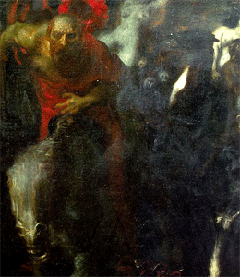Bland psykologen CG Jungs allra främsta, inspirerade och mest spännande verk återfinns den lilla artikeln Wotan, på sammanlagt mindre än 20 sidor. Jung försökte där att förstå vilka krafter det var som låg bakom den tyska nationalsocialismen och Tredje Riket, och hans teori är att det var sedan länge nedtryckta sidor av den tyska folksjälen, arketyper, som med explosiv kraft återinträdde på den historiska arenan. Jung, som fortfarande i grunden är psykolog och saknar en känsla för det som är mer än mänskligt, kallar dessa sidor för Wotan efter den tyska guden (motsvarigheten till den svenske Oden). Jung beskriver hur centrala sidor av guden och arketypen Wotan, hans rastlösa vandrande, hans koppling till storm och wut/besatthet/bärsärkaraseri, återkommit hos det tyska folket. Intressant i sammanhanget är hans avslutande ord, där han inser att storm- och krigsgud är bara en sida av Wotan, och att man på sikt även skulle få se hans mer fredliga sidor återkomma. Nu blev det naturligtvis inte så, eftersom ett världskrig kom emellan som tyskarna förlorade, men man kan bara spekulera i vad som kunde ha skett annars. Jung är heller inte odelat positiv till att ett helt folk blir ”besatt” av en storm- och krigsgud, men det är ändå det bästa han skrivit.
Jungs analys upprepades nästan 100 år senare av Michael Moynihan, i Lords of Chaos, där han menade att den tidiga norska blackmetalscenen var en liknande explosiv återkomst av för-kristna teman och arketyper.
But what is more than curious – indeed, salacious to a degree – is that an ancient god of storm and rage, the long latent Wotan, should awake, like an extinct volcano to new activity, in a civilised country that is supposed to have outgrown the Dark Ages for a long time. We have seen him come to life in the German Youth Movement, right at the beginning the blood of several sheep was shed in honour of his resurrection. Armed with backpack and lute, blond youths, sometimes girls as well, could be noticed as restless wanderers on every road from the North Cape to Sicily, faithful adherents of the roaming god… Later, toward the end of the Weimar Republic, the wandering role was taken over by the thousands of unemployed people, who one could encounter everywhere on their aimless rambles… By 1933 they were no longer wandering, but marched in hundreds of thousands.

Wotan is a restless wanderer who creates unrest and stirs up strife, now here, now there, and works magic. Christianity soon transformed him into the devil, and he only lived on in blurring local traditions as a ghostly hunter who was seen with his retinue, flickering like a will o’ the wisp through the stormy night.
….
Nietzsche’s case is certainly a peculiar one…. In 1863 or 1864, in his poem ”To the Unknown God”, Nietzsche had written:
I shall and will know thee, Unknown One,
Who searchest out the depths of my soul,
And blowest through my life like a storm,
Ungraspable, and yet my kinsman!
I shall and will know thee, and serve thee.
….
Wotan disappeared when his oaks fell and appeared again when the Christian God proved too weak to save Christendom from a fratricidical bloodbath. When the Holy Father at Rome could only impotently lament before God the fate of the grex segregatus, the one-eyed hunter, on the edge of the German forest, laughed and saddled Sleipnir.
….
In fact I venture the heretical suggestion that the unfathomable depths of Wotan’s character explain more of National Socialism than all three reasonable factors put together.
…
The impressive thing about the German phenomenon is that one man, who is obviously ”possessed”, has infected a whole nation to such an extent that everything is set in motion and has started rolling on its course towards perdition.
It seems to me that Wotan hits the mark as a hypothesis. Apparently he really was only asleep in the Kyffhäuser mountain until the ravens called him and announced the break of day. He is a fundamental attribute of the German psyche, an irrational psychic factor which acts on the high pressure of civilisation like a cyclone and blows it away.
….
Archetypes are like riverbeds which dry up when the water deserts them, but which it can find at any time. An archetype is like an old watercourse along which the water of life has flowed for centuries, digging a deep channel for itself. The longer it has flowed in this channel, the more likely it is that sooner or later the water will return to its old bed… All human control comes to an end when the individual is caught in a mass movement. Then the archetypes begin to function, as happens also in the lives of individuals when they are confronted with situations that cannot be dealt with in any of the familiar ways.
….
If we apply our admittedly peculiar point of view consistently, we are driven to conclude that Wotan must, in time, reveal not only the restless, violent, stormy side of his character, but also his ecstatic and mantic qualities – a very different aspect of his nature. If this conclusion is correct, National Socialism would not be the last word. Things must be concealed in the background that we cannot imagine at present, but we may expect them to appear in the course of the next few years or decades.












